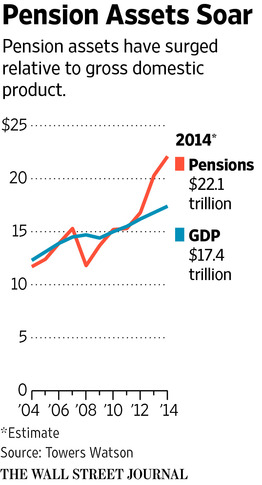The value of U.S. pension assets has outpaced GDP growth over the last decade, according to data from Towers Watson.
In that time frame, pension assets have grown at a rate twice that of the country’s GDP.
From the Wall Street Journal:
Pension investments in stocks, bonds, cash and alternative assets such as real estate have surged relative to the country’s gross domestic product over the last decade. The value of U.S. pension assets jumped over 89% while GDP rose roughly 42%, according to data from consulting firm Towers Watson & Co.
Those investments were worth an estimated $22.1 trillion last year, 127% of the country’s $17.4 trillion gross domestic product. That’s the highest percentage on record, and up nearly 32 percentage points from a decade earlier.
[…]
U.S. pension investments accounted for more than 61% of the $36.1 trillion global total. That total is 84% of global GDP. Global pension assets relative to global GDP are up roughly 15 percentage points from the decade earlier.
The dollar is strong relative to foreign currencies, and U.S. companies have more money available, which widens the disparity, Mr. Ruloff said. U.S. pension plans last year made 67% of their equity investments in U.S. stocks, according to Towers Watson.
Towers Watson reported last month that global pension asset values reached all-time highs in 2014.


